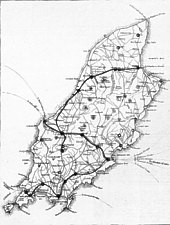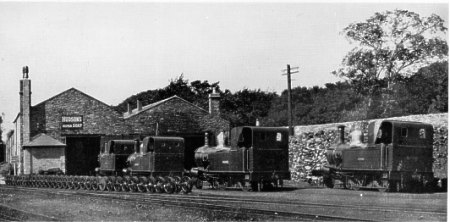
Map of Isle of Man Railways
IT is the weakness of small communities, and perhaps especially of island communities to regard their own little fragment of territory as the hub of the universe-to quote Tennyson, "they think the cackle of their rustic burg the murmur of the world." The Isle of Man, measuring 227 square miles and housing 50,000 inhabitants, is not immune from this weakness. There is a story of a Manxman from one of the remoter rural areas who for the first time visited Liverpool and, during his wanderings there, mentioned "the Island." "What Island?" he was asked. "The Isle of Man, of course!" was his reply, "what other island is there ?" It might be geographically correct, nevertheless, to describe the Isle of Man as the hub of the British Isles. It lies almost mathematically midway between England, Scotland, Ireland and Wales. Views of Cumberland, South Scotland and the mountains of Mourne are to be had almost daily from the promenades of Douglas, Ramsey, Peel and Port Erin, and North Wales is visible in favourable weather and from certain vantage points. Passenger steamship routes radiate to Liverpool, Fleetwood, Heysham, Ardrossan (for Glasgow), Belfast, Dublin, and occasionally to Llandudno, and efficient railway communications continue the spokes of the wheel to its circumference.
This central position is an immense asset to a community which lives on its earnings as a holiday resort.
The Isle of Man draws the bulk of its visitors from Lancashire and Yorkshire and it enjoys very great popularity as a holiday resort among our own people at Gorton Foundry.
The Island's capital, Douglas, combines the go-ahead energy of Blackpool with a foreground and background of exquisite loveliness; on the other hand, those whose mood is placid can, in the smaller towns and in almost any rural nook they select, enjoy the loveliness without the man-made aids to pleasure. A blend of many styles may be incongruous and grotesque in architecture, but never in scenery. Nature knows no clashes. And there can scarcely be any area similarly small which affords so many contrasts between Nature's sublimity and Nature's sweet simplicity. Awe-inspiring cliffs dropping almost perpendicularly into the sea, exquisite glens where graceful streams, issuing from banks clothed with ferns and over hung with foliage, roll in foaming cascades over the rock face; noble mountain lines, wide vistas of plain and coast, all are to be found here and all can be delighted in during one day's excursion. It is almost impossible to pass for more than half-an-hour out of sight of the sea, a sea which in summer is a perfect emblem of peace and reflects all the humours of radiant sun and fleecy cloud.
The Island is rich in archaeological remains and in antiquities generally, as may be evidenced by visits to Castle Rushen, the decayed Peel Castle and Cathedral, and the ruins of a very ancient Cistercian monastery at Rushen Abbey, or by a visit to the Manx Museum, which houses, among numerous treasures, a wonderful collection of casts of Runic crosses erected by the descendants of the Vikings who colonized the Island in the ninth and tenth centuries.
Railwaymen visiting the Island will naturally direct a friendly scrutiny upon the local railway system. The Isle of Man Railway Company which serves the whole Island, having many years ago absorbed an independent line from Ramsey to St. John's and a small offshoot to the mining village of Foxdale, was founded in 1873 at the instance of prominent local merchants and landed proprietors, who were assisted to a considerable extent by British investors.
The then Duke of Sutherland, whose relative Mr. Henry Broughham Loch, afterwards High Commissioner for South Afrca and a peer, was Governor of the Island, was Chairman of the Company, and was succeeded by Sir John Pender, M. P.
During 1925, the last pre-strike year, the Company carried 1,344,620 passengers. Compare that figure with the Island's native population, and an idea can be formed of the Island's popularity and the degree to which the Railway participates in that popularity. It is remarkable that, despite the competition of the charabancs-a competition which is being intensified by a service of motor omnibuses - the number of passengers carried by rail has multiplied enormously as compared with the years before the war.
Starting at Ramsey, the northernmost town and a seaport, the line runs southwest to the village of Ballaugh, thence south for several miles, and thence curving inland till it reaches the Island's central village, St. John's, within a stone's throw of Tynwald Hill, where the laws passed by the Island's legislature are publicly proclaimed in Manx and English every fifth of July. Thence the main line runs in a straight line eastward to Douglas, the Island's capital. The next branch runs southward from Douglas to Castletown, where is situated the splendidly preserved old Norman fortress of Castle Rushen and also the public school made famous in Dean Farrar's story, King William's College, and thence due westward to Port St. Mary and Port Erin, a small town charmingly located in the extreme south-west, and, appropriately to its name, the part of the Isle of Man nearest to Ireland. A spur shoots out from the centre at St. John's and runs into Peel, city of the ruined islet cathedral and of the castle familiar to readers of Sir Walter Scott's "Peveril of the Peak." The total mileage on all lines is 46¼.
To cope with the heavy summer passenger traffic the Company has 16 locomotives, many of them christened after past and present Directors of the Company. Fifteen of these engines are of the 2-4-0 type and 14 are practically identical and have cylinders 11"x 18" and coupled wheels 3'9" diameter and pony truck wheels 2' 9". The Tank capacity is 450 gallons, boiler pressure 160 lb. per square inch, and their weight when full just over 20½ tons. They are controlled by both steam and hand brakes.

Douglas Engine Shead and Workshop
The last engine of the type to be supplied has been named "Mannin" and was delivered in March 1926. This engine, having Cylinders 12" x 18" and boiler pressure of 180 lb. per square inch, is more powerful than the others. The wheels are of similar dimensions but the total weight is just over 23¼ tons. This engine has been equipped with a vacuum automatic brake in addition to the steam and hand brakes in anticipation of the time when the whole of the passenger rolling stock of the Company will be so fitted.
 Locomotive "Mannin" in service |
All these engines have been built at Gorton Foundry.
It is of interest to note that the first seven engines delivered have completed an average mileage of 1,000,000 miles.
Engine No. 5, "Mona," has actually made 1,285,000 miles since it was delivered in June 1874 and the original boiler ran for over 143,000 miles before it was replaced.
The remaining engine of the stock is the solitary six wheels coupled tank engine named "Caledonia." It was originally purchased for working the once heavy mineral traffic on the Foxdale line. This engine is the work of Messrs. Dubs & Co. of Glasgow. It has Cylinders 13½" x 18", coupled wheels 3' 4" diameter, tank capacity 400 gallons, and a boiler pressure of 150 lb. per sq. inch. The coaching stock consists of 115 vehicles, most of which are bogie coaches, and, in addition, there are 176 merchandise and mineral wagons of the two axle type. The gauge of the railway is 3' 0" and the permanent way is laid with 60-1b. steel rails of the flat bottom type. Apart from the Foxdale branch which has a gradient of 1 in 46 the steepest gradient on the railway is 1 in 64 for 2¼ miles long combined with curves of ten chains radius. This gradient is on the Port Erin line, about half a mile from Douglas Station.
Across two of the wide glens between Peel and Kirkmichael (on the Ramsey line) two steel lattice viaducts have been built, each with three 60-ft. spans.
|
|
||
|
|
||
| Any comments, errors or omissions gratefully received The
Editor HTML Transcription © F.Coakley , 2011 |
||